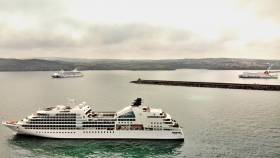Displaying items by tag: Unexpected caller
Rosslare-Fishguard Ferry Arrives to Welsh Port Where Cruiseship Total Doubles At Short Notice
On Monday of last week Afloat tracked a ferry arriving in the Port of Fishguard, Wales where two cruiseships one scheduled the other totally unexpected called to the scenic north Pembrokeshire port, writes Jehan Ashmore.
The ferry Stena Nordica (deputising for 'Europe') had departed Rosslare Harbour on a routine crossing of the St. Georges Channel to the Port of Fishguard is operated by Stena Line Ports. On arrival of the ferry into Fishguard Bay was the scene involving a pair of anchored cruiseships, one within the harbour while the other was offshore of the port's breakwater.
Of the pair, Aidavita was the scheduled caller to the Welsh port which was visited by the German operated cruiseship. The 1,266 passenger ship had previously arrived in the port at around dawn having made an overnight passage through the Irish Sea from Greenock, Scotland.
As for the second surprise ship, this was Seabourn Quest which departed the Bristol Channel from Portbury. The 450 guest cruiseship however did not call to another Welsh port as intended. The port been Milford Haven located in the south of Pembrokeshire.
Instead, Afloat noted the twin funnelled cruiseship took a course along the stunning rugged Pembrokeshire National Coastal Park to include taking a passage between the mainland and Skokholm Island. In addition while en route to Fishguard, the ship past Skomer Island.
The reason for the none show of the high-end luxury cruiseship was not due to operator Seabourn Cruise Line but the Milford Haven Port Authority which operates the Port of Milford Haven. The port is the UK's largest energy port and is capable of delivering 30% of the nation's gas demand.
In response to Afloat as to the reason for Seabourn Quest none show a spokesperson for the Port of Milford Haven commented: "We were extremely disappointed that Seabourn Quest was unable to call to Milford Haven. Unlike many Ports, at Milford Haven the tugs are not contracted to the Port but to our (energy) terminal customers and, on rare occasions, this does have the potential to impact on cruise calls as it did".
The Port added "that ultimately, the terminals will decide whether to release a tug for a cruise vessel based on their shipping requirements and the Port has to accept the decisions made. While this is the first time for many years that this situation has arisen, it clearly can occur.
So what was one port's loss was a gain for a neighbouring port on either side of the Welsh west coast region.
Seabourn Quest's unexpected call to Fishguard was a welcome boost to the port and the local economy. Reception teams organised by the Fishguard Bay Welcome (Tourism Information Centre) greeted passengers and crew ashore from tenders of both Aidavita and Seabourn Quest.
A more recent visitor took place last Friday when the mini superyacht like Variety Voyager made an appearance. The diminutive cruiseship operated by Variety Cruises has a capacity for just 71 guests.




























































